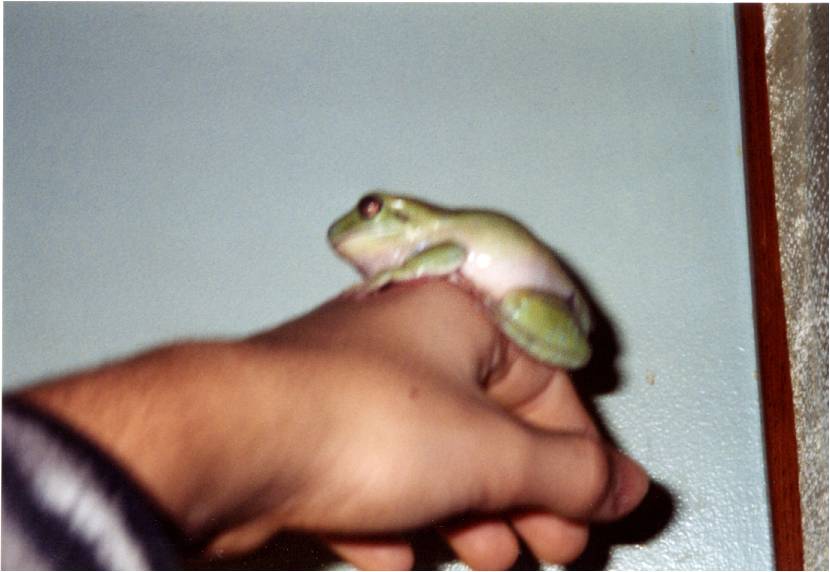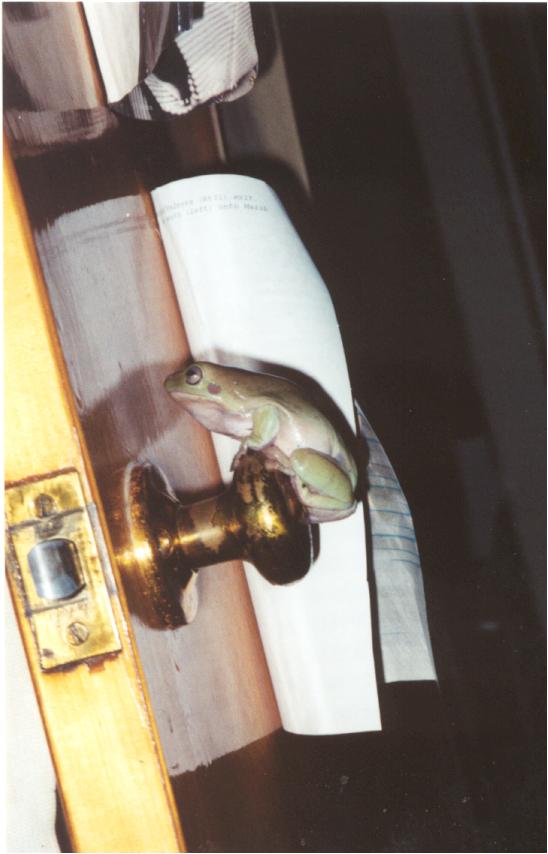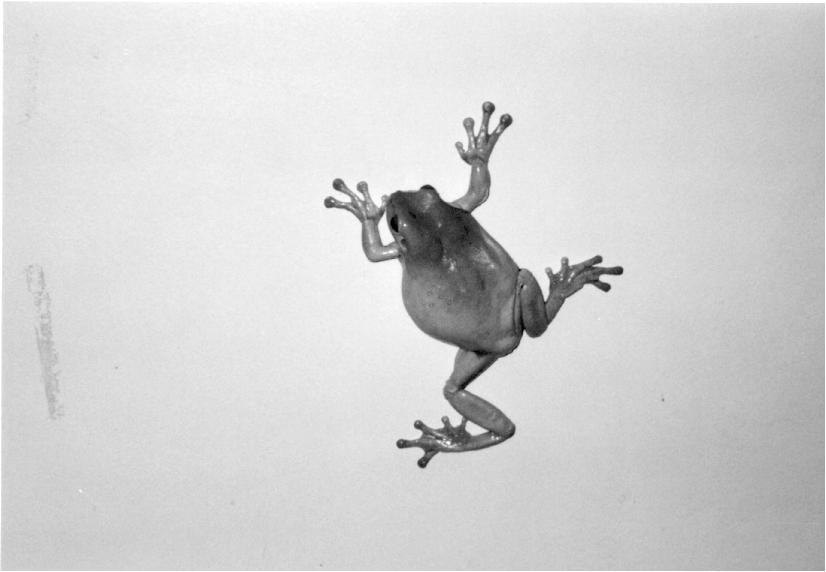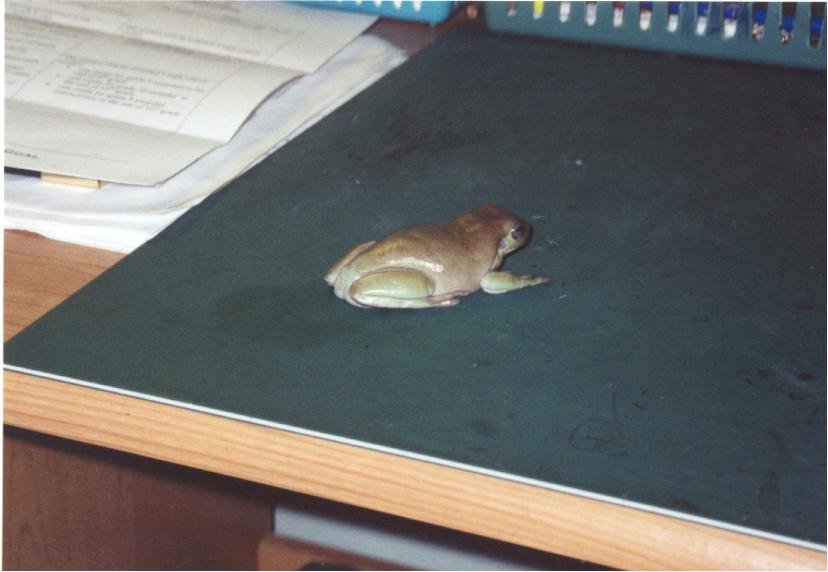|
Whites Dumpy Tree Frog
Litoria caerulea
Whites Dump Tree Frogs are naturally found in Indonesia, New Guinea, and parts of Australia. They are one of the largest tree frogs in the world, females growing up to 6 inches in length and males around 4.5 inches. They are very fat frogs thus making them very hardy in a time of famine. You know your frog isnt healthy if its head flab (otherwise known as tympanic ridges) doesnt somewhat overlap the tympanic membranes (ear holes). Their skin is very smooth and sensitive, constant handling can make them sick. Almost half the frogs body weight is composed of water they absorb through their highly permeable skin. They can change their skin color depending on mood; generally light green means theyre satisfied. They have pads on the end of their fingers that allow them to stick to almost any smooth surface, with the exception of tree bark. Its not so much a suction cup action as most people refer to it as, but the way the cells on the pads are composed allow it to maintain a large friction between surfaces coming into contact with them. They can live for up to 20 years Im told, average is 8-10 years. Mine have been around for at least the 6 years Ive had them. The skin contains blue and green pigments, with yellow pigments layered on top of it. Eventually the yellow layer can wear off and then the frogs skin appears blue.
If you are to go out and purchase a Whites Dumpy Tree Frog, select a healthy looking one, one with no scars and seems energetic and youthful (almost impossible to tell due to their restful day time hours in the corners of the tank). I hate how supposed pet experts say you need at least twenty-five gallons for two at a time, thats bullshit. You could keep two in a ten gallon and they wouldnt mind, let alone telling the difference. They spend the majority of the day, about 16 hours, sleeping, stuck to a corner of the tank. The 8 hours theyre actually awake, theyll sit in water (I hope to hell youve provided some sort of water bowl/mini-basin) and soak or move to another side of the glass and stick there. Younger ones (1-4 year olds) may be apt to actually exploring the cage and jumping around or hiding. You should provide some sort of wood piece resembling the side of a tree. You can either go out and buy one at the store or find a piece of wood in your backyard, just soak in bleach over night then soak it in cold water the next night. As for the water bowl, you can use tap water. A lot of people say not to, because supposedly the chlorine in it will damage their sensitive skin, another bullshit! Ive used tap water for my two frogs ever since I got them and theyre just as healthy as ever. In order to keep them healthy besides proper water supply, they need lighting during the day to sleep in, a UV bulb or regular bulb works fine, and some people say that a red UV bulb at nighttime works well. I keep a timer on my light for my Tree Frog cage (20 gallon, only because I keep my smaller animals in the other cages I have) and it turns the light on at 10 in the morning and off at 8 in evening. The last thing you need to provide for proper health is food. The best way to do so would be to feed them a variety of insects, making sure they get the proper nutrients from different bugs. Although, I find the most cost efficient way is to buy a bunch of crickets from the local pet store (Pet-Smart), bath them in vitamin dust, and then feed them to the frogs. Its also good to feed your crickets 24 hours prior to feeding because you get them fat and nutritious enough for digesting, common sense (also known as gut loading). I feed mine that jelly substance you can buy at your local pet store, but cut apple pieces work fine. I feed my tree frogs 3 crickets each every other night. If you have a baby Whites Tree Frog, they should be fed 6 per day, with about 3 hours in between, every day. The main thing is to simulate their natural environment as best as possible. For the land, peat moss works the best Ive seen; Bed-a-beast is a brand of peat moss I use. Maintain a temperature of 75°F to 90°F in the tank. You must consider, that people took them out of their natural habitat for the sake of commercial use and your satisfaction of a pet, might as well make your slaves have a half decent life similar to their old.
If you were to breed your tree frogs (assuming you have one male and one female), you must go through a lengthy process. First off, have a water bowl with the water at least 5 inches deep, helps if you have some sort of fake water plants as well. You can tell males from females by four things. One, the females are larger than the males (at adolescent age). Second, the males have a gray wrinkly throat area where a flap of skin extends from the neck during their mating call/croak. Third, only males can perform a mating call. And four, males develop nuptial pads on their feet, which are swollen parts of the skin, made to grasp the female during sex. You should have about a month where you feed the frogs very little, have very little water in the tank, and the temperature dropped to about 70°F. This is to simulate wintertime. The next month, put the regular tank settings back, very moist (recommended misting the tank wit a spray bottle), very warm and plenty of food, this represents springtime. This will make the male frog want to look for a mate, so he will begin croaking/mating calls at nighttime. Mine call whenever they hear a large persistent drone of noise like the radio, vacuum cleaner, or television. After a few weeks, sometimes in a matter of days, the female will accept the males call, find him, and then have froggy sex in the water bowl. Its important not to disturb them at all during this process or it may fail and stress out the female tremendously, miscarriages have been known to kill the female. The male will be on the back of the female, the female lays between 150 and 300 eggs in the water, moving them and entangling them around plants stems with her legs, while the male frog will be spraying out his sperm in sync with her eggs discharge. It can take up to three days, for the eggs to hatch; they hatch as tadpoles, and then about two weeks for metamorphosis into small frogs. They mature after one year.
|  |

|
| Litoria caerulea on my hand |

|
| Litoria caerulea on door nob |

|
| Litoria caerulea on wall (black and white for some reason) |

|
| Litoria caerulea on desktop |

|
| Litoria caerulea on desktop 2 |
|
|

